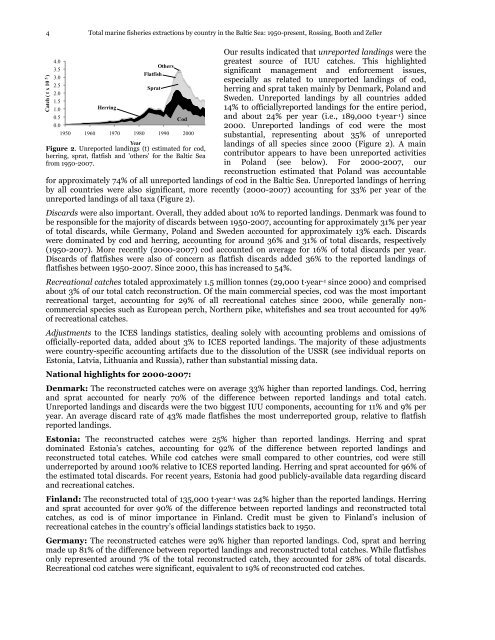Total marine fisheries extractions by country in the Baltic Sea
Total marine fisheries extractions by country in the Baltic Sea
Total marine fisheries extractions by country in the Baltic Sea
Create successful ePaper yourself
Turn your PDF publications into a flip-book with our unique Google optimized e-Paper software.
Catch ( t x 10 5 )<br />
4 <strong>Total</strong> <strong>mar<strong>in</strong>e</strong> <strong>fisheries</strong> <strong>extractions</strong> <strong>by</strong> <strong>country</strong> <strong>in</strong> <strong>the</strong> <strong>Baltic</strong> <strong>Sea</strong>: 1950-present, Ross<strong>in</strong>g, Booth and Zeller<br />
4.0<br />
3.5<br />
3.0<br />
2.5<br />
2.0<br />
1.5<br />
1.0<br />
0.5<br />
0.0<br />
Herr<strong>in</strong>g<br />
O<strong>the</strong>rs<br />
Flatfish<br />
Sprat<br />
Cod<br />
1950 1960 1970 1980 1990 2000<br />
Year<br />
Figure 2. Unreported land<strong>in</strong>gs (t) estimated for cod,<br />
herr<strong>in</strong>g, sprat, flatfish and 'o<strong>the</strong>rs' for <strong>the</strong> <strong>Baltic</strong> <strong>Sea</strong><br />
from 1950-2007.<br />
Our results <strong>in</strong>dicated that unreported land<strong>in</strong>gs were <strong>the</strong><br />
greatest source of IUU catches. This highlighted<br />
significant management and enforcement issues,<br />
especially as related to unreported land<strong>in</strong>gs of cod,<br />
herr<strong>in</strong>g and sprat taken ma<strong>in</strong>ly <strong>by</strong> Denmark, Poland and<br />
Sweden. Unreported land<strong>in</strong>gs <strong>by</strong> all countries added<br />
14% to officiallyreported land<strong>in</strong>gs for <strong>the</strong> entire period,<br />
and about 24% per year (i.e., 189,000 t∙year -1 ) s<strong>in</strong>ce<br />
2000. Unreported land<strong>in</strong>gs of cod were <strong>the</strong> most<br />
substantial, represent<strong>in</strong>g about 35% of unreported<br />
land<strong>in</strong>gs of all species s<strong>in</strong>ce 2000 (Figure 2). A ma<strong>in</strong><br />
contributor appears to have been unreported activities<br />
<strong>in</strong> Poland (see below). For 2000-2007, our<br />
reconstruction estimated that Poland was accountable<br />
for approximately 74% of all unreported land<strong>in</strong>gs of cod <strong>in</strong> <strong>the</strong> <strong>Baltic</strong> <strong>Sea</strong>. Unreported land<strong>in</strong>gs of herr<strong>in</strong>g<br />
<strong>by</strong> all countries were also significant, more recently (2000-2007) account<strong>in</strong>g for 33% per year of <strong>the</strong><br />
unreported land<strong>in</strong>gs of all taxa (Figure 2).<br />
Discards were also important. Overall, <strong>the</strong>y added about 10% to reported land<strong>in</strong>gs. Denmark was found to<br />
be responsible for <strong>the</strong> majority of discards between 1950-2007, account<strong>in</strong>g for approximately 31% per year<br />
of total discards, while Germany, Poland and Sweden accounted for approximately 13% each. Discards<br />
were dom<strong>in</strong>ated <strong>by</strong> cod and herr<strong>in</strong>g, account<strong>in</strong>g for around 36% and 31% of total discards, respectively<br />
(1950-2007). More recently (2000-2007) cod accounted on average for 16% of total discards per year.<br />
Discards of flatfishes were also of concern as flatfish discards added 36% to <strong>the</strong> reported land<strong>in</strong>gs of<br />
flatfishes between 1950-2007. S<strong>in</strong>ce 2000, this has <strong>in</strong>creased to 54%.<br />
Recreational catches totaled approximately 1.5 million tonnes (29,000 t∙year -1 s<strong>in</strong>ce 2000) and comprised<br />
about 3% of our total catch reconstruction. Of <strong>the</strong> ma<strong>in</strong> commercial species, cod was <strong>the</strong> most important<br />
recreational target, account<strong>in</strong>g for 29% of all recreational catches s<strong>in</strong>ce 2000, while generally noncommercial<br />
species such as European perch, Nor<strong>the</strong>rn pike, whitefishes and sea trout accounted for 49%<br />
of recreational catches.<br />
Adjustments to <strong>the</strong> ICES land<strong>in</strong>gs statistics, deal<strong>in</strong>g solely with account<strong>in</strong>g problems and omissions of<br />
officially-reported data, added about 3% to ICES reported land<strong>in</strong>gs. The majority of <strong>the</strong>se adjustments<br />
were <strong>country</strong>-specific account<strong>in</strong>g artifacts due to <strong>the</strong> dissolution of <strong>the</strong> USSR (see <strong>in</strong>dividual reports on<br />
Estonia, Latvia, Lithuania and Russia), ra<strong>the</strong>r than substantial miss<strong>in</strong>g data.<br />
National highlights for 2000-2007:<br />
Denmark: The reconstructed catches were on average 33% higher than reported land<strong>in</strong>gs. Cod, herr<strong>in</strong>g<br />
and sprat accounted for nearly 70% of <strong>the</strong> difference between reported land<strong>in</strong>gs and total catch.<br />
Unreported land<strong>in</strong>gs and discards were <strong>the</strong> two biggest IUU components, account<strong>in</strong>g for 11% and 9% per<br />
year. An average discard rate of 43% made flatfishes <strong>the</strong> most underreported group, relative to flatfish<br />
reported land<strong>in</strong>gs.<br />
Estonia: The reconstructed catches were 25% higher than reported land<strong>in</strong>gs. Herr<strong>in</strong>g and sprat<br />
dom<strong>in</strong>ated Estonia‘s catches, account<strong>in</strong>g for 92% of <strong>the</strong> difference between reported land<strong>in</strong>gs and<br />
reconstructed total catches. While cod catches were small compared to o<strong>the</strong>r countries, cod were still<br />
underreported <strong>by</strong> around 100% relative to ICES reported land<strong>in</strong>g. Herr<strong>in</strong>g and sprat accounted for 96% of<br />
<strong>the</strong> estimated total discards. For recent years, Estonia had good publicly-available data regard<strong>in</strong>g discard<br />
and recreational catches.<br />
F<strong>in</strong>land: The reconstructed total of 135,000 t∙year -1 was 24% higher than <strong>the</strong> reported land<strong>in</strong>gs. Herr<strong>in</strong>g<br />
and sprat accounted for over 90% of <strong>the</strong> difference between reported land<strong>in</strong>gs and reconstructed total<br />
catches, as cod is of m<strong>in</strong>or importance <strong>in</strong> F<strong>in</strong>land. Credit must be given to F<strong>in</strong>land‘s <strong>in</strong>clusion of<br />
recreational catches <strong>in</strong> <strong>the</strong> <strong>country</strong>‘s official land<strong>in</strong>gs statistics back to 1950.<br />
Germany: The reconstructed catches were 29% higher than reported land<strong>in</strong>gs. Cod, sprat and herr<strong>in</strong>g<br />
made up 81% of <strong>the</strong> difference between reported land<strong>in</strong>gs and reconstructed total catches. While flatfishes<br />
only represented around 7% of <strong>the</strong> total reconstructed catch, <strong>the</strong>y accounted for 28% of total discards.<br />
Recreational cod catches were significant, equivalent to 19% of reconstructed cod catches.





![Nacion.com, San José, Costa Rica [Nacionales] - Sea Around Us ...](https://img.yumpu.com/26166123/1/190x245/nacioncom-san-josac-costa-rica-nacionales-sea-around-us-.jpg?quality=85)










